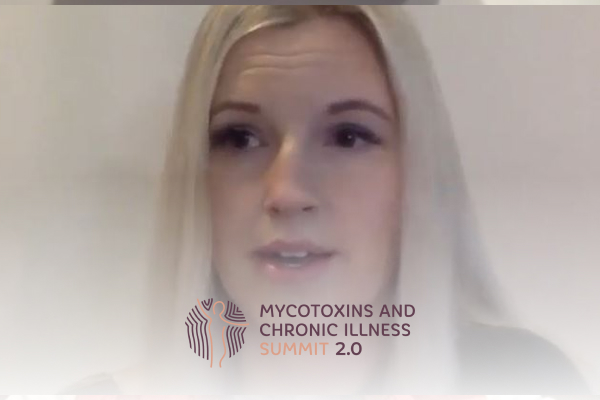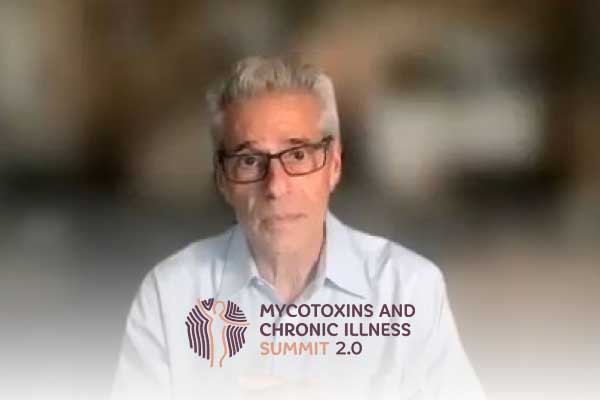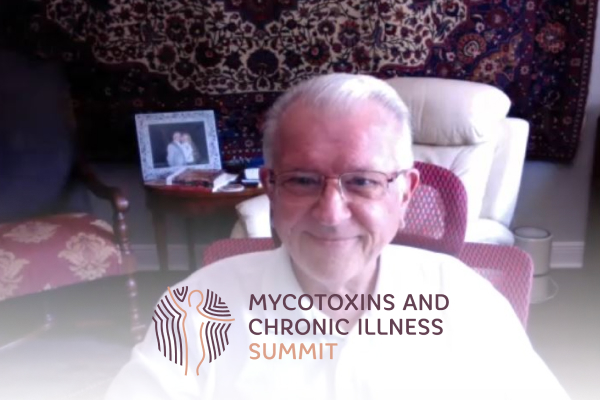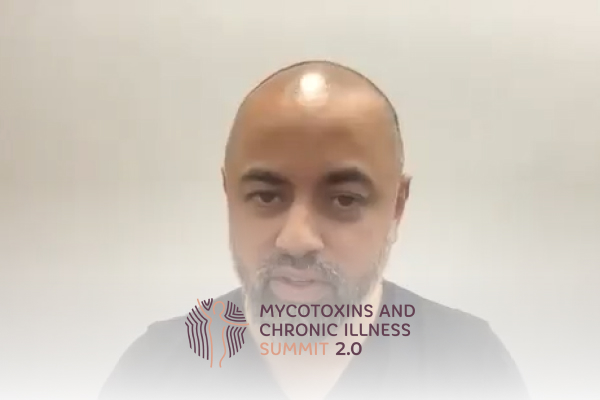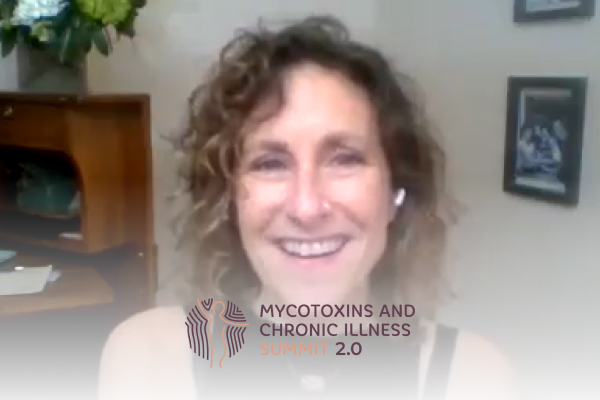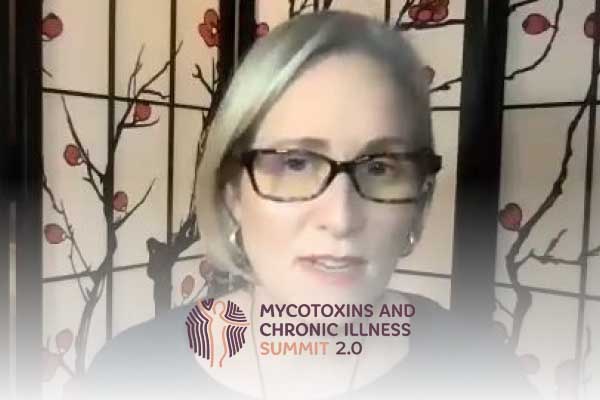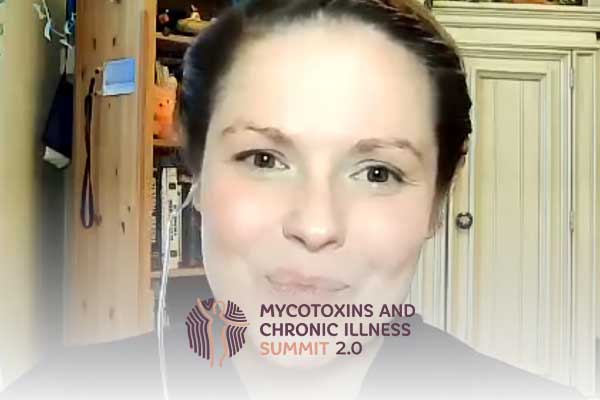Join the discussion below

Dr. Amanda Wilms is a naturopathic physician who graduated from Bastyr University with a special interest in complex chronic illness. She completed advanced training in intravenous therapy, injection techniques, ozone therapy, mycotoxin illness, autonomic response testing, environmental medicine/toxicology, autoimmune conditions, bio-identical hormones, PANDAS/PANS, and Lyme disease. Read More
- How symptoms are different for children with mold exposure.
- Working with children to support liver to detox mycotoxins.
- How mycotoxins confuse the brain and creates an autoimmune attack specific to PANS
Amanda Wilms, N.D.
Hi, my name is Amanda Wilms. I’m a naturopathic doctor. I am honored to be a part of the Microtoxin Summit and excited to hear the other lectures, other information that’s presented. I primarily deal with complex chronic illness. So mold and mycotoxin exposure is very, very common in my practice. It’s something I’m very passionate about, it’s a very tricky topic, tricky thing to deal with, but so, so important. And it’s such a common problem unfortunately. So the topic I wanted to talk about today is one that’s very dear to me, it’s mycotoxins and PANS. So PANS, it’s an acronym. It stands for pediatric acute neuropsychiatric syndrome. It’s actually usually paired with PANDAS, you usually see pandas PANS because they’re very similar. PANDAS is an acronym am standing for pediatric autoimmune neuropsychiatric disorder associated with strep.
So what happens in these kids is it’s basically an autoimmune reaction where they have brain inflammation. And the common symptoms are going to be neuropsychiatric, so OCD, anxiety, anger, fear, a whole host of that things can change. There’s a lot of regression that can happen as well, where if the kids were once reading and writing, all of a sudden, they’re not able to write in full sentences, their handwriting may change, sometimes bedwetting, baby talk, just going backwards in the phases of typical development. There also can be true physical manifestations as well where the kids start developing ticks and a whole host of other physical symptoms as well, pain, abdominal pain, digestive issues, rashes. It does depend on what the trigger is.
So with PANDAS, again, it’s associated with strep. So strep A is the bacteria that, you usually get the exposure, you get the swollen sore throat. A lot of times fever, . Strep itself is very well known to trigger a lot of downstream negative effects. So like Scarlet fever, rheumatic fever. That’s why in the conventional medical world, it’s pretty common to just jump straight to antibiotics to get the strep treated, get the infection under control. So none of these downstream issues can take hold. So with PANS, it’s basically the same thing, it’s the same type of symptoms that happen but the trigger is different. So many things can trigger PANS. It can be triggered by viruses, bacteria, parasites, toxins, even major traumas and stressors can trigger that. But today, of course, we’re gonna talk about mycotoxins as the trigger.
So what it normally looks like with PANS and PANDAS is just this overnight change. A lot of parents will say, oh, my kid went to bed, totally fine, normal, woke up the next day and was a nightmare. So commonly, like I said, they’ll have aggression, OCD, anxiety, regressions. It doesn’t always look like that. Sometimes it is a lot slower progression or maybe just one or two symptoms will show up and as time goes on, more and more things start to spiral. And I know both of these also say pediatric in part of their names, but this can happen to adults as well. It’s just most of the research and knowledge base is really surrounding kids right now but this can be a part of other adult issues also. So with PANS and mold exposure. Again, it’s tricky, mold is very, very tricky because it doesn’t always present as the normal symptoms that people experience. So normally with mold exposures, you think of upper respiratory issues like asthma and coughing and runny nose, chronic sinus congestion, rashes, even allergies, but especially with kids, it’s hard for them to verbalize and really explain what’s going on sometimes. So there may be some symptoms and some weird things they’re feeling.
If they say their head feels funny or just not feeling too well, little extra tired. Usually there’s some type of preceding events again but it’s just when these big psychiatric things happen, that’s the big ticket. So with mold and microtoxin exposures, really what happens is, well, there’s three big things I like to talk about with patients. The first thing that you really need to look at and deal with is the mycotoxins themselves. The second thing is this immune system response. And the third thing is treating this infection itself or the infections I should say. So I’ll go into all of those. But the very first thing is the mycotoxins. So the mycotoxins themselves are the actual, it’s like the metabolic byproducts of molds.
So there’s different types of molds, like black mold, the Stachybotrys, like aspergillus, penicillin. Those are very common types of molds from water damage buildings. And each itself produces different types of mycotoxins. There are some overlaps, but in general when you’re doing some testing, like if you do a urine mycotoxin testing, it’s looking for these specific types of toxins to see which mold spores themselves are present. And so with the actual toxins themselves, we know, regardless of what type of mold it is, they’re usually very detrimental to the system, they’re very tissue toxic. Each type of mold may have a little bit different affinity for different tissue types or organ system. But in generals mycotoxins are very damaging, they’re carcinogenic, they alter the immune function, they cause tissue damage, a whole host of negative downstream effects.
So the first goal of course is to stop the mold exposure. And that alone sounds fairly easy, but again, it’s tricky. It’s finding where the exposure is from. A lot of the times it is from the home, if there is any kind of water damage, a leak in the roof, a leak in a pipe, a toilet, a sink. And then trying to find what the best option is, if remediation is the best, if moving out, but also looking at other potential exposures, a lot of times it’s kids schools or a car. There can be a whole host of things. And genetics are at play with this as well. Many individuals, they can have a certain level of mold exposures and the body is resilient enough where you’re not real having huge detrimental symptoms.
There are, it’s called the dreaded mold gene, these HLA genes where they assume about 25 to 20% of the population actually has these genes where the liver just can’t process mycotoxins and the immune system mounts an inappropriate response. So for those specific individuals with those mold, that dreaded mold gene, it’s maybe even one big exposure, even if you went on vacation, stayed in a moldy hotel room or something like that may be enough to trigger this reaction. So it’s always hugely important to find out what the exposure was, stop the exposure so that the mycotoxins themselves are no longer being absorbed into the system and breathed into the system because they’re micro microscopic, you can’t see them, but if you’re living in a moldy room, they’re gonna be absorbed in the skin, they’re are going to be inhaled into the sinuses, into the lungs, down into the GI tract.
So stopping that exposure of course is number one. But the second piece is helping to facilitate the removal. With mycotoxins, the number one thing I do is binders, binders are anything that are going to pass through the GI tract and just absorb and pull whatever’s floating in the system so that they’re not reabsorbed. So the binders can be things like charcoal, fibers, chlorella, clay, there’s even a couple prescription ones out there, like cholestyramine which is actually a prescription medication to help with lowering cholesterol, but it works beautifully from binding mycotoxins and getting it out through the stool so that it’s not reabsorbed or stored in tissues.
Other things are really helpful for that as well. Of course, liver support. Our livers are basically our body’s filters. So as much as we can support our livers through that process as well, the better the body’s going to respond. So things like glutathione, NAC, curcumin, milk thistle, there’s a whole host of things that really support the liver to help with getting these mycotoxins out as well. But facilitating very gentle microtoxin removal is number one. And there’s a lot of great options for kids too. Part of the tricky part with kids is compliance and taste.
So a lot of the times I’ll use chlorella for kids, that’s a really great one where it’s really tiny little tablets that they swallow. And a lot of kids, even if they can’t swallow them, they’ll chew them up and swallow it. It kind of has a little bit of a seaweed taste, a little bit of an acquired flavor, but I have a lot of kids that will do that. And there’s other binders like fibers and things that you can mix with water, add a little bit of juice or something flavorful.
So they’ll get it down. And then a lot of herbs, you can get glyceride forms too, so they don’t have alcohol and they kinda have a better flavor to get in. So that’s the first piece, is stopping the mycotoxin exposure, trying to gently facilitate them getting out. And the other piece of it is healthy fats too. So mycotoxins, they actually can be water soluble and fat soluble. So the more you just flood the body with healthy fats, for one, it’s also very helpful for the nervous system and so many other benefits from healthy fats, but it helps to flush these mycotoxins out of the body. So a lot of the times, I’ll do fish oils and just including extra coconut oils and nuts and seeds and olive oil in the diet. But another one of my absolute favorites is phosphatidylcholine.
That’s the molecule, it’s the main component of every membrane, every cell membrane in our body. So it’s a real, really great option as well to help with, just flushing these mycotoxins out and also helping to repair any damage that may have occurred. Antioxidants as well, that’s another one that’s fairly easy to get in kids just eating the color of the rainbow in foods. They can be supplemented of course as well, but as my much of those purples and reds and yellows, oranges, those are also gonna be really helpful. So the second piece of this after stopping the exposure, helping with mycotoxin removal is really the immune system piece. And this can actually be one of the trickier parts.
So mold and mycotoxins, part of the reason that they can create such a whole wide variety of symptoms is they really confuse the immune system. What they do is there’s main parts to our immune systems, there’s the innate immune system, the immune system you’re born with, and then there’s the acquired immune system. So that’s when you know, you’re exposed to different viruses and bacterias, your body is producing antibodies to help fight those. But mycotoxins actually impact the innate immune system and can both cause immune suppression and immune confusion. And that’s where really where this PANS issue comes in.
So there’s multiple reasons of why it can happen, I won’t go through all the details, but it basically confuses, the mycotoxins confuse the body to into thinking that it needs to attack its own tissue. So what happens is you get this autoimmune response to different parts of the brain and specifically with PANS, it’s the basal ganglia. So that part of the brain when you have this autoimmune attack and inflammation, it can create these emotional outbursts and these changes in their neuropsychiatric behavior. And even again like the mobility, the ticks, and other things that can come downstream from that. But that’s the big driving force. So it’s almost like the brain is on fire.
So with this piece, it’s really getting the immune system to fall back into place. So a lot of times, I even am guilty of this of saying, oh, we need to boost the immune system, boost the immune system, but in this case, it’s really, that’s the last thing we wanna do. We want to actually modulate and regulate the immune system. So there’s lots of ways of doing this. And I do think it can be done at the same time as you’re working on getting the microtoxins out of the body. But this is really where there’s a whole host of things. Like I use a lot of LDI, it stands for low dose immunotherapy. It’s basically a homeopathic way to modulate and reregulate the body’s immune system to mycotoxins ’cause it’s really this misguided attempt to treat. So LDI can work beautifully. There’s other homeopathics that work beautiful as well.
I also love the prescription low dose naltrexone. This is a medication that helps with basically shifting the body out of this like Th2 inflammatory response. There’s some other herbs that can work beautifully, transfer factors. There’s a whole host of things that can help with modulating and getting the immune system to calm down. In the conventional medical world, they actually will use steroids for this. And I will say, I do use them sometimes if we just can’t get it calmed down ’cause we have to save the brain. So although as a naturopath, like prescribing steroids is not my favorite thing, in order to protect the brain, it’s worth it. This also is where sometimes people will use IVIG.
It’s an IV of immune of immune globulins that’s donated from multiple donors and it’s like a reboot to the immune system. I don’t advise or recommend it super often but sometimes it’s needed in severe cases, and it can be a game changer. The other kind of higher level thing that we do occasionally if needed is stem cells. That can be another really great way of rebooting the immune system and getting this attack, this brain on fire to stop. And so with all of those things, of course, any types of like anti-inflammatory herbs and anti-inflammatory treatments can be helpful as well just to get the immune system to normalize, to modulate and to stop this attack. And there’s different ways of testing to find out too if this is happening, which I think are of course, very, very important in this situation to actually find out for sure that this is happening. A lot of times we’ll use the Cunningham Panel, this tests for different immune antibodies that are looking for specific activity on the brain. There’s a few others that can work well.
Also like Neural Zoomer has some great antibodies as well to see exactly like which area of the, both the brain and the peripheral nervous system may be involved. And of course, depending, all of this is so individualized, but also depending on the the child too, like looking at the gut, that’s a very common reason that there’s other molecular mimicry, other autoimmune activity going on. If there’s foods that they’re eating that they’re allergic to, or other infections, other issues that could be happening. I truly think our bodies are very resilient and it’s usually not just one thing, usually there’s a host of things involved with that. And then the third piece of this with, so the first was getting the microtoxins under control, looking at the immune system reactivity, getting that under control. And now the third piece is really treatment.
So mold itself loves warm moist environments. So I mean the best place for that is our sinuses, lungs, our GI tract. So unfortunately not only can you be impacted from the microtoxin themselves, but the molds spores, the fungal spores can actually take hold in the body and grow. So you do have to look at ways of treating that. And so there’s, again, a whole host of ways, there’s natural options, herbals, prescriptions I use like Sporanox. But with that, and with this like dysregulated immune response, you also open the door to other infections. Mold is very commonly a trigger for other infectious processes to thrive. So things like lyme disease like Borrelia and co-infections like Babesia, Rickettsia, bartonella, microplasma, all of these different types of bacterial infections, parasites, viruses. They can all be opportunistically given the chance to rise up and cause issues in the body and take over.
So the treatment phase is also one where you really need to look, kind of cast a broad net on the different things that may be, may be present and creating symptoms. So that piece also is testing, looking at different ways of gathering information on what else maybe keeping this inflammatory cycle going and maybe keeping the body inflamed and not able to reregulate. So it is an overwhelming process, especially for parents and this system, the conventional system we work in, this really isn’t well know, well talked about issue, but the more information we get out there and the more that, more that parents share their stories as well with their kids, the faster that people are going to find the right providers and the right treatments. Because with PANS and PANDAS, there is a really positive outcome.
Like most kids do have huge improvements and unfortunately there can be flares, if there’s triggers in the future, especially the kids that do have these genetics where their body just can’t detox or has inappropriate responses to mycotoxins, or even the kids with PANDAS where it’s actually strep that’s triggering this. If there’s another strep infection down the line, that can also trigger another PANDAS episode. So there may be some lifelong predisposition or weaknesses, but overall these symptoms and this brain inflammation, it definitely can be reversed. And with mold and mycotoxins, it’s definitely a trickier one with all the different exposures that people may have.
It’s a meaning that you need to test homes before you move. And air purifiers, just being more cautious about the things that may trigger another episode in these kids. But overall, like I said, there are very good outcomes and prognosis, it’s just finding the culprit, finding that trigger and then making sure all of these steps are followed so that the kids can have a full recovery. So I know this is a lot of information and their topics, I feel like we could talk about for a long period of time but for right now, I’ll leave it at those. And hopefully this helps somebody in finding a resource for why their child may be acting out or if this patterning fits. So hopefully this was helpful and I’m excited to see all the other speakers and hear what they have to say. So thank you for listening and hope to see you soon.
Downloads

